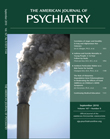Posttraumatic Stress Without Trauma in Children
Abstract
Objective:
It remains unclear to what degree children show signs of posttraumatic stress disorder (PTSD) after experiencing low-magnitude stressors, or stressors milder than those required for the DSM-IV extreme stressor criterion.
Method:
A representative community sample of 1,420 children, ages 9, 11, and 13 at intake, was followed annually through age 16. Low-magnitude and extreme stressors as well as subsequent posttraumatic stress symptoms were assessed with the Child and Adolescent Psychiatric Assessment. Two measures of posttraumatic stress symptoms were used: having painful recall, hyperarousal, and avoidance symptoms (subclinical PTSD) and having painful recall only.
Results:
During any 3-month period, low-magnitude stressors occurred four times as often as extreme stressors (24.0% compared with 5.9%). Extreme stressors elicited painful recall in 8.7% of participants and subclinical PTSD in 3.1%, compared with 4.2% and 0.7%, respectively, for low-magnitude stressors. Because of their higher prevalence, however, low-magnitude stressors accounted for two-thirds of cases of painful recall and half of cases of subclinical PTSD. Moreover, exposure to low-magnitude stressors predicted symptoms even among youths with no prior lifetime exposure to an extreme stressor.
Conclusions:
Relative to low-magnitude stressors, extreme stressors place children at greater risk for posttraumatic stress symptoms. Nevertheless, a sizable proportion of children manifesting posttraumatic stress symptoms experienced only a low-magnitude stressor.



